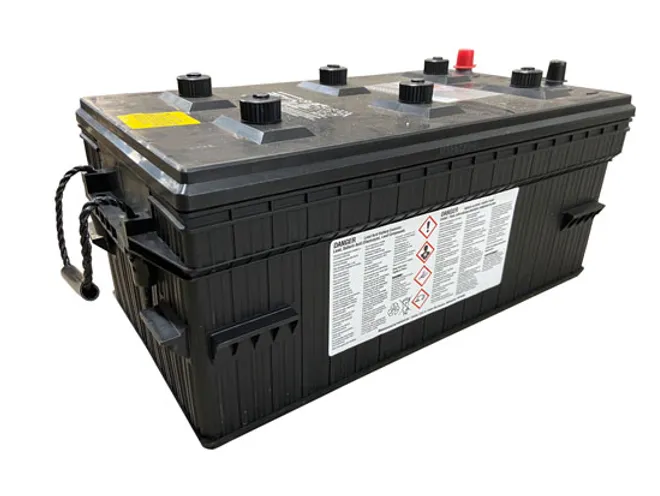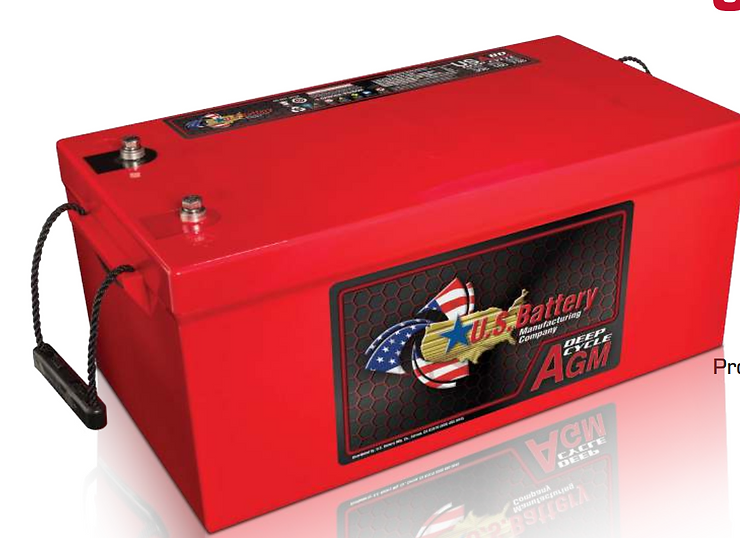Introduction
In this post, I want to take some time to discuss the different types of batteries available and commonly used in bus and truck fleets. This topic is crucial yet often overlooked until you receive the dreaded "My vehicle won't start" phone call.
I started my career in the fleet maintenance industry and vividly remember the all-too-common winter trip to Oneonta, NY, with a new set of batteries to jump-start a bus for the morning run—a journey that takes at least two hours each way, even on a good day! Even just having to jump start or change out batteries in the yard can prove daunting when it is -10F and snowing.
The following discussion aims to shed light on the various types of batteries, how they work, and what you should observe when operating your fleet.
Types of Group 8D Batteries
There are numerous types of batteries, but for this discussion, we will focus on the most commonly used ones in large bus and truck fleets. This information is also applicable to smaller batteries used in light-duty applications, or the 4-battery configuration that sometimes replaces the two large 8D batteries. All batteries list some or all of the ratings shown below and should always be considered when selecting replacement batteries.
Key Ratings to Consider:
- Reserve Capacity (RC):
Indicates how long, in minutes, the battery will provide 25 amps of current until it is discharged (10.5 volts). - Amp Hours (AH):
Measures the number of amps the battery can supply in one hour. - Cranking Amps (CA):
The maximum current available for 30 seconds at temperatures above 32°F. - Cold Cranking Amps (CCA):
The amount of current available on a fully charged battery at 0°F for 30 seconds. - Terminal Type:
Ensures the battery fits into the vehicle's design.
Lead-Acid Batteries:
The first battery we'll discuss is the Group 8D battery, a powerhouse that provides substantial power when properly maintained.
Description:
- The Group 8D is a large, robust battery commonly used in heavy-duty vehicles.
- It is available in standard lead-acid form, the most common and least expensive option.

StandardLeadAcidBattery, image: hamiltonmarine.com
Types:
- Maintenance-Free:
- Requires no additional maintenance to the battery itself.
- Technicians do not need to check or refill the cells with acid.
- Standard (Flooded Lead-Acid):
- Requires periodic checking of individual cells to ensure they are covered with acid.
- Loses some acid through gassing during recharge, which cannot be recaptured.
Cost:
- Typically ranges from $200 to $400, depending on the energy storage capacity.
Usage Considerations:
- Larger RC or AH ratings mean longer intervals between charge sessions, crucial for vehicles that tend to consume power when turned off.
- Cranking amps (CA and CCA) are critical for starting engines, especially in cold weather.
- In 24-volt applications, replace batteries in pairs to avoid performance issues due to mismatched capacities.
- Lead-acid batteries are designed as "starting batteries" and not for continuous heavy electrical loads when the engine is off. This misuse can shorten their lifespan.
Common Issues:
- Complaints about buses failing to start after a few days often result from battery drain. Even a small, continuous draw can deplete the battery if the vehicle is idle for extended periods.
- Draining batteries below 90% for even a short period of time can start to degrade battery performance and lifespan.
Absorbed Glass Mat (AGM) Batteries:
AGM batteries are becoming increasingly popular in the industry due to their durability, maintenance-free nature, and better ability to still provide enough energy after being discharged to a low level.

Absorb Glass Matt (AGM) deep cycle battery, image: usbattery manufacturing company datasheet
Description:
- AGM batteries do not require maintenance of fluid levels, as there are no free fluids inside.
Key Features:
- Deep Cycle Capability:
Superior to lead-acid batteries for applications requiring consistent current and voltage over extended periods before recharging. - Sulfation Prevention:
While AGM batteries are more resistant to sulfation, they can still deteriorate quickly if mistreated.
Special Considerations:
- Requires specific recharging procedures and benefits from regular charging sessions with a charger designed for AGM batteries.
- Vehicle alternators alone may not provide adequate recharging, potentially shortening the battery’s lifespan despite higher upfront costs.
- Heavier and more challenging to handle, with some models weighing as much as 169 lbs.
Gel Batteries:
Gel batteries, although less common, are sometimes used in fleet applications.

Gel battery, image: Trojan Motive datasheet
Description:
- Gel batteries contain a gelified electrolyte that reduces leakage and maintenance requirements.
Key Features:
- Deep Cycle Capability:
They are ideal for applications requiring consistent power between charging, such as motorhomes or entertainer vehicle house batteries. - Climate Suitability:
Best suited for warmer climates. They are not typically used as the primary (starting) battery in vehicles because they are not designed for that purpose. Many gel batteries do not provide CA or CCA measurements.
Charging Considerations:
- Specific charging requirements are crucial to realize the benefits of gel batteries.
- Charging solely with an alternator will degrade and wear out the battery sooner than expected. Proper chargers designed for gel batteries are necessary to maintain their longevity and performance.
Which Battery Would I Choose?
When conducting research on batteries, I prioritize manufacturers that provide comprehensive information about their products, especially regarding critical factors like CA and CCA ratings, ensuring reliable vehicle startups in various weather conditions.
Key Considerations:
- Detailed Information: Look for brands that offer clear datasheets and charging recommendations for their batteries. This demonstrates a commitment to quality and longevity.
- Critical Ratings: Pay close attention to CA and CCA ratings to ensure adequate starting power, regardless of weather conditions - for your vehicle.
- Cost-Effectiveness: While cost-effective doesn't mean opting for the cheapest option, I typically lean towards maintenance-free lead-acid batteries for starting applications.
- Prevention of Errors: Maintenance-free batteries help prevent errors such as adding the wrong acid or neglecting to check levels regularly.
- Brand Reliability: Choose brands that prioritize consumer education and provide transparent information about their products.
Manufacturer Transparency:
- Manufacturers like USBattery, Trojan, and Optima which offer detailed cycle life charts based on discharge frequency and depth, exemplify a commitment to informing consumers about battery performance expectations.

Example battery comparison, image: US Battery datasheet
Optimal Fleet Maintenance:
- Identifying and addressing drain sources is crucial for maintaining battery health in the vehicle. Turning off devices draining power when the bus shuts down significantly extend battery life.
- Small increases in current can have large effects on the total number of hours the battery will remain charged as shown in the figure below.
- Avoid masking underlying issues with larger or pricier batteries. Addressing the root cause of battery drain is paramount to prevent premature battery failure.

Example of 200 Ah battery running time at new, 20% worn, and 40% worn
By prioritizing detailed information, critical ratings, and brand reliability, fleet operators can make informed decisions when selecting batteries, ensuring optimal performance and longevity for their vehicles.
Battery Program: Tools and Maintenance
Maintaining batteries correctly necessitates the use of appropriate tools, which every shop should have as part of its battery program.
Proper Battery Chargers
Charger Selection:
- Avoid using oversized "buzz box" chargers with confusing dials and timers, as they can be dangerous and often cause more harm than good.
- Opt-in for chargers like the NOCO 10 Amp battery charger for small fleets or the NOCO 4 Bank unit for larger shops.
- Look for chargers with the capability to charge different battery types, such as AGM and Lead Acid, and ensure they are true "multi-stage" chargers that adjust charging rates based on battery conditions.
- If cost is a deterrent there are less expensive but still adequate units, such as the DSR125.
Charging Practices:
- Discourage regular jump-starting of batteries, as it can lead to further damage. Instead, remove low batteries for charging before use or charge them on the vehicle first before attempting to start again.
- Incorporate battery charging into regular shop maintenance schedules, ensuring that vehicle batteries receive a complete charge during preventive maintenance services. This ensures that batteries benefit from a proper charge at least once a month, which is crucial for most fleet operations.
Benefits of Proper Charging:
- Ensures batteries are fully charged and maintained, prolonging their lifespan and reliability.
- Prevents unnecessary downtime and costs associated with premature battery failure.
- Enhances overall fleet performance and efficiency by ensuring vehicles start reliably.
By utilizing proper battery chargers and incorporating regular charging into shop maintenance routines, fleet operators can ensure optimal battery performance, longevity, and overall fleet reliability.
Battery Testing
Testing batteries regularly is essential for ensuring they are in good condition to remain in service and to verify that purchased batteries meet expectations.
Carbon Pile Load Tester (manual method):
- Historically used, but less common nowadays.
- Applies a high draw to the battery and measures voltage and current for a brief test period.
- Requires knowledgeable technicians to interpret results accurately.
Modern Digital Testers
Key Features:
- Analyzes battery resistance digitally to assess condition.
- Provides clear understanding of battery health.
- Differentiates between sealed lead-acid and AGM batteries, ensuring accurate testing for specific battery technologies.
Selection Considerations:
- Ensure the tester can analyze the battery technology used in your fleet.
- Testers are rated for maximum CCA rating, which must be input before testing to avoid inaccurate results.
Testing Protocol:
- Test new batteries upon arrival to verify performance and quality.
- Charge old batteries before testing to ensure accurate results.
- Some dealers may recharge dead batteries and resell them if they test good, highlighting the importance of thorough testing before disposal.
Benefits:
- Identifies weak or failing batteries before they cause downtime or performance issues.
- Ensures purchased batteries meet specifications and provide expected performance.
- Enhances overall fleet reliability and performance by maintaining healthy batteries in service.
By utilizing modern digital testers and following a comprehensive testing protocol, fleet operators can verify battery condition accurately and ensure reliable performance from their battery inventory.
Summary
Navigating through the complexities of automotive batteries is crucial for fleet maintenance managers, as batteries play a pivotal role in vehicle reliability and performance. This guide sheds light on various battery types, maintenance practices, and testing procedures to ensure optimal fleet operation:
- Understanding Battery Types: From traditional lead-acid batteries to modern AGM and gel batteries, each type has its unique characteristics and applications. Selecting the right battery type for your fleet's needs is essential.
- Maintenance Practices: Implementing proper maintenance practices, such as regular charging, testing, and addressing parasitic draws, can extend battery life and prevent unnecessary downtime.
- Testing Protocols: Utilizing modern digital testers ensures accurate assessment of battery health, enabling proactive battery management and replacement when necessary.
- Addressing Complex Issues: Some battery-related issues may require a more nuanced approach, including identifying and addressing external factors contributing to early battery failures.
- Expert Consultation: When faced with persistent battery issues, seeking expert consultation can provide fresh insights and solutions to improve fleet reliability and performance.
By proactively managing battery maintenance and addressing underlying issues, fleet managers can minimize costs and maximize uptime, ensuring smooth operations and enhanced performance for their fleets. If you're struggling with battery-related challenges, don't hesitate to reach out for assistance. We are here to provide expert guidance and support tailored to your fleet's specific needs. Contact me or schedule an appointment if you would like to get in touch.